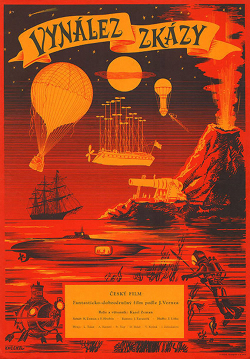
Jules Gabriel Verne was a French novelist, poet, and playwright. His collaboration with the publisher Pierre-Jules Hetzel led to the creation of the Voyages extraordinaires, a series of bestselling adventure novels including Journey to the Center of the Earth (1864), Twenty Thousand Leagues Under the Seas (1870), and Around the World in Eighty Days (1872). His novels, always well documented, are generally set in the second half of the 19th century, taking into account the technological advances of the time.

Twenty Thousand Leagues Under the Seas is a classic science fiction adventure novel by French writer Jules Verne.

The green flash and green ray are meteorological optical phenomena that sometimes occur transiently around the moment of sunset or sunrise. When the conditions are right, a distinct green spot is briefly visible above the Sun's upper limb; the green appearance usually lasts for no more than two seconds. Rarely, the green flash can resemble a green ray shooting up from the sunset or sunrise point.

Captain Nemo is a character created by the French novelist Jules Verne (1828–1905). Nemo appears in two of Verne's science-fiction books, Twenty Thousand Leagues Under the Seas (1870) and The Mysterious Island (1875). He also makes a brief appearance in a play written by Verne with the collaboration of Adolphe d'Ennery, Journey Through the Impossible (1882).

Raphael Semmes was an officer in the Confederate Navy during the American Civil War. Until then, he had been a serving officer in the US Navy from 1826 to 1860.

John Frederick Clute is a Canadian-born author and critic specializing in science fiction and fantasy literature who has lived in both England and the United States since 1969. He has been described as "an integral part of science fiction's history" and "perhaps the foremost reader-critic of sf in our time, and one of the best the genre has ever known." He was one of eight people who founded the English magazine Interzone in 1982.

The Voyages extraordinaires is a collection or sequence of novels and short stories by the French writer Jules Verne.

Robinsonade is a literary genre of fiction wherein the protagonist is suddenly separated from civilization, usually by being shipwrecked or marooned on a secluded and uninhabited island, and must improvise the means of their survival from the limited resources at hand. The genre takes its name from the 1719 novel Robinson Crusoe by Daniel Defoe. The success of this novel spawned so many imitations that its name was used to define a genre, which is sometimes described simply as a "desert island story" or a "castaway narrative".

The First Men in the Moon is a scientific romance, originally serialised in The Strand Magazine and The Cosmopolitan from November 1900 to June 1901 and published in hardcover in 1901, by the English author H. G. Wells, who called it one of his "fantastic stories". The novel tells the story of a journey to the Moon undertaken by the two protagonists: a businessman narrator, Mr. Bedford; and an eccentric scientist, Mr. Cavor. Bedford and Cavor discover that the Moon is inhabited by a sophisticated extraterrestrial civilisation of insect-like creatures they call "Selenites". The inspiration seems to come from the famous 1865 book by Jules Verne, From the Earth to the Moon, and the opera by Jacques Offenbach from 1875. Verne's novel also uses the word "Selenites" to describe inhabitants of the Moon.

Off on a Comet is an 1877 science fiction novel by French writer Jules Verne. It recounts the journey of several people carried away by a comet contacting the Earth. The comet passes by various bodies in the Solar System before returning the travelers to the Earth.

Facing the Flag or For the Flag is an 1896 patriotic novel by Jules Verne. The book is part of the Voyages extraordinaires series.
An omnibus edition or omnibus is a book containing multiple creative works by the same or, more rarely, different authors. Commonly two or more of the works have been previously published as books, but a collection of shorter works, or shorter works collected with one previous book, may also be known as an omnibus.

Invention for Destruction is a 1958 Czechoslovak black-and-white science fiction adventure film, directed by Karel Zeman, produced by Zdeněk Novák, and starring Lubor Tokoš, Arnošt Navrátil, and Miloslav Holub. Based on several works by Jules Verne, primarily his 1896 novel Facing the Flag, the film evokes the original illustrations for Verne's works by combining live actors with various forms of animation.

Captain Antifer is an adventure novel written by Jules Verne. The novel tells of a treasure hunt, where the clues – arriving in bits and pieces – lead the seaman Pierre Antife of Saint-Malo and various others of diverse nationalities and backgrounds on a complicated route – from Tunisia to the Persian Gulf, the Gulf of Guinea, and then to Edinburgh, Spitzbergen, and finally to the Mediterranean off Sicily.

Comets have appeared in numerous works of fiction.

Na kometě is a 1970 Czech film directed by Karel Zeman, based on Jules Verne's 1877 novel Off on a Comet.
Valley of the Dragons is a black and white 1961 American science fiction film loosely based on Jules Verne's Off on a Comet and heavily dependent on stock footage from the movies One Million B.C., King Dinosaur, Cat-Women of the Moon and Rodan. Director Edward Bernds says the film was built around stock footage from One Million B.C.

Scientific Detective Monthly was a pulp magazine that published fifteen issues beginning in January 1930. It was launched by Hugo Gernsback as part of his second venture into science-fiction magazine publishing, and was intended to focus on detective and mystery stories with a scientific element. Many of the stories involved contemporary science without any imaginative elements—for example, a story in the first issue turned on the use of a bolometer to detect a black girl blushing—but there were also one or two science fiction stories in every issue.

The near future has been used as a setting in many works, usually but not limited to the genre of science fiction. It has become increasingly common in works from the 18th century onward, with some of the classic works in the genre being Jules Verne's Journey to the Centre of the Earth (1864) and H. G. Wells' The War of the Worlds (1898). 20th century saw works such as George Orwell's Nineteen Eighty-Four (1949) or the novels of William Gibson, the latter representing the emergence of the popular cyberpunk genre. While some, particularly early, works of this genre are optimistic showcases of technological and societal progress, many others are discussing emergent social problems such as environmental problems, overpopulation, oppressive political regimes or the possibility of a nuclear holocaust.

Space travel, or space flight is a classic science-fiction theme that has captivated the public and is almost archetypal for science fiction. Space travel, interplanetary or interstellar, is usually performed in space ships, and spacecraft propulsion in various works ranges from the scientifically plausible to the totally fictitious.


















